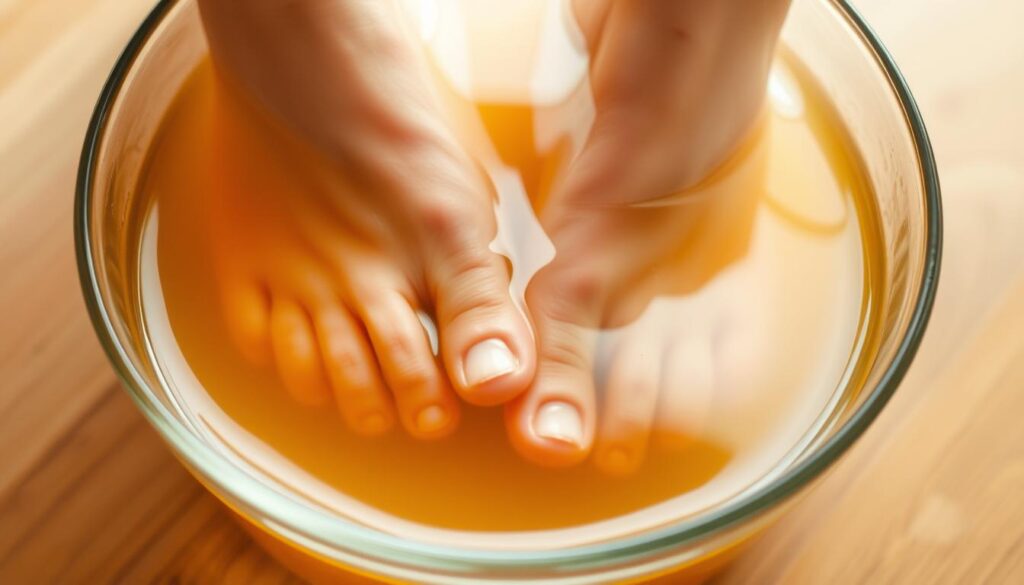Vinegar Soak for Toenail Fungus: Effective Natural Treatment & How to Use It
Contents
- 1 Understanding Toenail Fungus: Causes and Symptoms
- 2 Why Vinegar Works Against Fungal Infections
- 3 Types of Vinegar for Toenail Fungus Treatment
- 4 Preparing an Effective Vinegar Soak for Toenail Fungus
- 5 Step-by-Step Guide to Vinegar Foot Soaking
- 6 Expected Results and Timeline
- 7 Combining Vinegar Soaks with Other Natural Remedies
- 8 Potential Side Effects and Precautions
- 9 Preventing Recurrence After Successful Treatment
- 10 Vinegar Soak for Toenail Fungus vs. Medical Treatments
- 11 Conclusion
Dealing with toenail fungus can be frustrating and embarrassing. Fortunately, a simple and effective natural remedy is available: a vinegar soak. This treatment has gained popularity due to its antifungal properties and ease of use.

The vinegar soak is not only a cost-effective solution but also a straightforward one. By mixing vinegar with warm water and optionally adding tea tree oil or Epsom salt, individuals can create a foot soak that helps combat fungal infections.
This article will guide you through the process of using a vinegar soak as a toenail fungus treatment, providing you with a comprehensive understanding of this natural remedy and how to effectively incorporate it into your foot care routine.
Understanding Toenail Fungus: Causes and Symptoms
Toenail fungus, also known as onychomycosis, is a fungal infection that can drastically change the appearance and health of your toenails. This condition is not just a cosmetic issue; it can also lead to discomfort and pain. Understanding the causes and recognizing the symptoms are crucial steps in managing and treating toenail fungus effectively.
Common Causes of Fungal Nail Infections
Fungal nail infections occur when fungi infect the nail or the skin around it. Poor foot hygiene is a significant risk factor, as it creates an environment conducive to fungal growth. Walking barefoot in public areas, sharing personal care items, and wearing tight or poorly ventilated shoes can also expose you to fungal spores. Additionally, certain health conditions, such as diabetes or a weakened immune system, can increase your susceptibility to fungal infections.
Other factors that contribute to the development of toenail fungus include aging, as older adults are more prone to fungal infections due to reduced blood circulation and slower nail growth. Trauma to the nail can also provide an entry point for fungi.
Recognizing the Signs of Toenail Fungus
The symptoms of toenail fungus can vary, but common signs include discoloration, thickening, and brittleness of the nails. Initially, you might notice a white or yellow spot under the tip of your toenail, which can gradually spread. As the infection progresses, the nail may become distorted, crumbly, or ragged. In severe cases, the nail can separate from the nail bed, causing pain and potentially leading to further complications.
Early recognition of these symptoms is key to effective treatment. If you notice any of these changes in your toenails, it’s essential to consider treatment options, such as a vinegar soak, to prevent the fungus from spreading and to promote healthy nail growth.
Why Vinegar Works Against Fungal Infections
The effectiveness of vinegar against fungal infections can be attributed to its unique composition and properties. Vinegar, particularly apple cider vinegar, has been widely recognized for its antifungal properties, making it a popular natural remedy for treating toenail fungus.
The Science Behind Vinegar’s Antifungal Properties
Vinegar’s antifungal efficacy is primarily due to its acidity. The acetic acid in vinegar creates an environment that is not conducive to fungal growth. Research has shown that acetic acid can effectively inhibit the growth of various fungi, including those responsible for toenail infections. This makes vinegar a valuable component of a vinegar foot soak treatment regimen.
pH Levels and Fungal Growth Inhibition
Fungal growth is significantly influenced by the pH level of its environment. Vinegar, being acidic, lowers the pH around the fungal infection, thereby inhibiting its growth. By creating an acidic environment, vinegar effectively disrupts the fungal infection’s ability to thrive, promoting healthier nail growth over time.
Types of Vinegar for Toenail Fungus Treatment
Various types of vinegar can be utilized for toenail fungus treatment, offering different benefits and drawbacks. The choice of vinegar can depend on availability, personal preference, and specific antifungal properties.

Apple Cider Vinegar Benefits
Apple cider vinegar is a popular choice for treating toenail fungus due to its antifungal properties and additional health benefits. It contains acetic acid, which helps in creating an acidic environment that inhibits fungal growth. Apple cider vinegar also has anti-inflammatory properties that can help soothe the affected area.
White Vinegar Options
White vinegar, primarily composed of acetic acid, is another effective option for treating toenail fungus. Its high acidity level makes it potent against a wide range of fungi. White vinegar is often more affordable and accessible than other types of vinegar, making it a practical choice for many people.
Other Vinegar Varieties and Their Effectiveness
While apple cider vinegar and white vinegar are the most commonly used types for toenail fungus treatment, other varieties like rice vinegar and malt vinegar can also be considered. However, their effectiveness may vary due to differences in acidity levels and additional compounds. It’s essential to research or consult with a healthcare professional before using less common types of vinegar for treatment.
Preparing an Effective Vinegar Soak for Toenail Fungus
A well-prepared vinegar soak can be a potent natural remedy for fungal nail infections. To get the most out of this treatment, it’s essential to understand how to prepare the solution correctly.
Basic Vinegar Solution Recipe
The basic recipe for a vinegar foot soak is straightforward and requires minimal ingredients. To start, mix 1 part vinegar with 2 parts warm water in a basin large enough to soak your feet comfortably. The warm water helps to open up the pores of your skin, allowing the antifungal properties of the vinegar to penetrate more effectively.
For a standard foot soak, you can use 1/2 cup of vinegar mixed with 1 cup of warm water. Adjust the quantities as needed to ensure the solution covers your toes and nails adequately.
Enhanced Formulas with Additional Ingredients
While the basic vinegar solution is effective, you can enhance its potency by adding other natural ingredients. Some options include:
- Tea tree oil: Known for its antifungal properties, adding a few drops can boost the solution’s effectiveness.
- Epsom salt: Can help reduce inflammation and soften toenails.
- Baking soda: May help neutralize foot odor and balance the pH of the skin.
Experiment with these ingredients to find a combination that works best for you.
Equipment and Supplies Needed
To prepare and use a vinegar foot soak, you’ll need the following equipment and supplies:
| Item | Description |
|---|---|
| Vinegar | Apple cider vinegar or white vinegar |
| Warm water | For soaking |
| Basin or foot tub | Large enough to soak feet |
| Towel | For drying feet after soak |
| Optional ingredients | Tea tree oil, Epsom salt, baking soda |
Step-by-Step Guide to Vinegar Foot Soaking
For those looking for a non-invasive treatment, a vinegar foot soak can be an excellent option for addressing toenail fungus. This natural remedy involves soaking your feet in a vinegar solution to create an environment inhospitable to fungal growth.
Proper Soaking Technique
To properly soak your feet, start by preparing a basin or foot tub with enough warm water to cover your feet. The water should be comfortable, not too hot or cold. Add the recommended amount of vinegar – typically one part vinegar to two parts water. Stir well to ensure the vinegar is fully dissolved.
Soaking your feet in this solution allows the antifungal properties of the vinegar to penetrate the nail and surrounding skin. It’s essential to soak your feet for the recommended duration to maximize the treatment’s effectiveness.
Recommended Duration and Frequency
The recommended duration for a vinegar foot soak is typically between 15 to 30 minutes. You can soak your feet once or twice a day, depending on the severity of the fungal infection and your personal preference.
| Soaking Frequency | Duration | Expected Outcome |
|---|---|---|
| Once a day | 15-30 minutes | Gradual improvement in fungal infection |
| Twice a day | 15-30 minutes | Faster improvement, but be cautious of skin irritation |
Post-Soak Care Tips
After soaking your feet, it’s crucial to dry them thoroughly, especially between the toes. This helps prevent further fungal growth. You can also apply an antifungal cream or oil to enhance the treatment’s effectiveness. For more information on foot soak treatments, you can visit Nuvectra Medical.
By following these steps and maintaining good foot hygiene, you can effectively use a vinegar foot soak as part of your toenail fungus treatment regimen.
Expected Results and Timeline
When using vinegar soaks for toenail fungus treatment, understanding the timeline for results is crucial for managing expectations. The effectiveness of this natural remedy for fungal nail infections can vary based on the severity of the infection and consistency of treatment.
Short-Term Changes You May Notice
In the initial stages of vinegar soak treatment, you may notice improvements in nail appearance and reduction in symptoms. These short-term changes can include a decrease in nail discoloration and a reduction in the thickness of the nail. Some users report a decrease in fungal debris under the nail.
Long-Term Effectiveness
The long-term effectiveness of vinegar soaks lies in their ability to create an environment inhospitable to fungal growth. With consistent use, vinegar’s antifungal properties can lead to significant improvements in nail health. It’s essential to continue treatment for the recommended duration to achieve optimal results.
When to Expect Visible Improvement
Visible improvements in nail health can be expected within several months of consistent vinegar soak treatment. The exact timeline varies depending on the severity of the fungal infection and the frequency of soaks. A general guideline is to continue treatment for at least 3 to 6 months before assessing its effectiveness.
The following table provides a general outline of what to expect during vinegar soak treatment:
| Timeline | Expected Changes |
|---|---|
| 1-3 months | Initial improvements in nail appearance, reduction in symptoms |
| 3-6 months | Noticeable reduction in fungal infection, improvement in nail health |
| 6 months and beyond | Significant improvement or complete resolution of fungal infection |
Combining Vinegar Soaks with Other Natural Remedies
While vinegar soaks are beneficial, combining them with other natural treatments may yield better results in treating toenail fungus. A comprehensive approach can involve multiple facets to tackle the infection effectively.
Essential Oils That Complement Vinegar Treatments
Certain essential oils, such as tea tree oil and oregano oil, have antifungal properties that can complement vinegar soaks. These oils can be added to the vinegar solution or applied directly to the affected nail after soaking.
Dietary Approaches to Support Fungal Treatment
A diet rich in nutrients can support the body’s natural defenses against fungal infections. Foods high in antioxidants, such as berries and leafy greens, and those containing probiotics, like yogurt, can be beneficial. A balanced diet can enhance the effectiveness of vinegar soaks.
Proper Foot Hygiene Practices
Maintaining good foot hygiene is crucial in both treating and preventing fungal infections. This includes regularly washing and drying the feet, wearing clean socks, and using antifungal powders or sprays. Combining these practices with vinegar soaks can significantly improve treatment outcomes.
By integrating vinegar soaks with other natural remedies and good foot care habits, individuals can adopt a holistic approach to treating toenail fungus, potentially leading to more effective results.
Potential Side Effects and Precautions
As with any treatment, vinegar soaks for toenail fungus can have side effects that need to be understood and managed. While generally considered safe, vinegar’s acidity can cause issues if not used properly.
Skin Irritation and How to Prevent It
Skin irritation is a potential side effect of using vinegar soaks. To minimize this risk, it’s recommended to dilute the vinegar with water and perform a patch test before starting the treatment. Start with a weaker solution and gradually increase the concentration as your skin becomes more tolerant.
When to Avoid Vinegar Soaks
There are certain situations where vinegar soaks should be avoided or used with caution. Individuals with open wounds, sensitive skin, or severe circulatory problems should consult a healthcare professional before starting treatment. Vinegar soaks are not recommended for people with certain medical conditions without proper medical guidance.
Special Considerations for Diabetic Patients
Diabetic patients need to be particularly cautious when using vinegar soaks due to their potentially compromised foot health and circulation. It’s essential for diabetics to consult with their healthcare provider before starting any new treatment, including vinegar soaks, to ensure it’s safe and appropriate for their condition.
Preventing Recurrence After Successful Treatment
To keep your toenails healthy and fungus-free after treatment, it’s essential to adopt some simple daily habits. Preventing the recurrence of toenail fungus requires consistent effort and attention to detail, but with the right strategies, you can maintain healthy nails.
Daily Habits to Maintain Fungus-Free Nails
Developing good daily habits is crucial in preventing fungal infections. This includes washing your feet daily and drying them thoroughly, especially between the toes. Regularly trimming your toenails and keeping them short can also help prevent fungal growth.
Footwear and Sock Recommendations
Wearing the right footwear and socks can play a significant role in preventing fungal infections. Choose breathable shoes and socks made from natural materials like cotton or wool. Avoid sharing footwear or socks, and consider using antifungal sprays or powders inside your shoes.
Maintenance Vinegar Soaks for Prevention
Using a vinegar foot soak once a week can be an effective way to maintain fungus-free nails. Mix 1 part of vinegar with 2 parts of water and soak your feet for 15-20 minutes. This helps to maintain the pH balance of your skin and prevent fungal growth.

| Prevention Method | Frequency | Benefits |
|---|---|---|
| Daily Foot Hygiene | Daily | Reduces fungal growth |
| Vinegar Foot Soak | Weekly | Maintains skin pH balance |
| Breathable Footwear | Ongoing | Reduces moisture accumulation |
Vinegar Soak for Toenail Fungus vs. Medical Treatments
Vinegar soaks offer a natural alternative to medical treatments for toenail fungus, but how do they compare in terms of effectiveness? Toenail fungus, a common condition that can cause thickening and discoloration of the nails, requires consistent treatment to cure. The antifungal properties of vinegar make it a popular choice for those seeking a natural remedy.
Comparing Effectiveness with Over-the-Counter Products
When comparing vinegar soaks to over-the-counter (OTC) products, several factors come into play. OTC treatments often contain antifungal ingredients like clotrimazole or terbinafine, which can be effective but may not work for everyone. Vinegar soaks, on the other hand, utilize the natural antifungal properties of acetic acid. While OTC products might offer quicker results, vinegar soaks provide a gentler, more natural approach.
| Treatment Type | Effectiveness | Potential Side Effects |
|---|---|---|
| Vinegar Soaks | Gradual improvement | Mild skin irritation |
| OTC Products | Faster results | Skin irritation, allergic reactions |
Cost Comparison with Prescription Treatments
The cost of vinegar soaks is generally lower than that of prescription treatments. Prescription antifungal medications can be expensive, especially for prolonged treatment courses. In contrast, vinegar is a common household item, making vinegar soaks a cost-effective option. However, it’s essential to consider the potential costs of failed treatment, as untreated toenail fungus can lead to more severe complications.
When to Consider Medical Intervention
While vinegar soaks can be an effective treatment for mild to moderate toenail fungus, there are instances where medical intervention is necessary. If the infection is severe, or if you experience pain, thickening of the nail, or difficulty walking, it’s crucial to consult a healthcare professional. Additionally, individuals with diabetes or compromised immune systems should seek medical advice to avoid potential complications.
Conclusion
Using a vinegar soak for toenail fungus is a straightforward and natural approach to treating fungal nail infections. By understanding the causes and symptoms of toenail fungus and leveraging the antifungal properties of vinegar, individuals can take a proactive step towards healthier feet.
Incorporating vinegar soaks into a comprehensive foot care regimen can be beneficial. Regular foot soaks, combined with proper foot hygiene practices and dietary approaches, can help prevent the recurrence of fungal infections.
As a natural remedy for fungal nail infections, vinegar soaks offer a cost-effective alternative to medical treatments. By following the guidelines outlined and being consistent with the treatment, individuals can potentially achieve significant improvements in their foot health.
Embracing simple foot care tips, such as using vinegar soaks, can lead to healthier and happier feet. This natural treatment approach encourages a holistic view of foot care, promoting overall well-being.